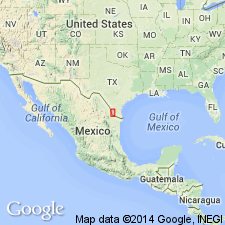
- Usage in publication:
-
- Sanchez sandstone member
- Modifications:
-
- Original reference
- Dominant lithology:
-
- Sandstone
- AAPG geologic province:
-
- Gulf Coast basin
Summary:
Pg. 1387. Sanches sandstone member of Fayette formation. Soft gray ridge-making sandstone with hard dark-brown calcareous concretionary masses. Two fossil horizons containing gastropods and bivalves and, at base, several beds of sandstone with plentiful OSTREA GEORGIANA. Thickness 139 feet. [Age is late Eocene.]
[Present in northeastern Mexico (Tamaulipas) and southern Texas (Starr County).] Lies 280 feet below top of Fayette formation in section measured on both sides of Rio Grande between Roma and Rio Grande City, [Starr Co.], southern TX. [Origin of name not stated.]
Source: US geologic names lexicon (USGS Bull. 896, p. 1905).

- Usage in publication:
-
- Sanchez sandstone tongue
- Modifications:
-
- Areal extent
- AAPG geologic province:
-
- Gulf Coast basin
Summary:
Pg. 259 (fig. 2), 269. Sanchez sandstone member of Fayette formation; Sanchez sandstone tongue of Fayette formation. Overlies Gorgora shale member (new) and underlies Agua Verde shale member (new). Thickness in Starr County, southern Texas, about 100 feet; thins and dies out half way across Zapata County, southwestern Texas. Fossils (CORBULA, VENERICARDIA, HALYMENITES). Age is late Eocene.
Source: US geologic names lexicon (USGS Bull. 1200, p. 3430); supplemental information from GNU records (USGS DDS-6; Denver GNULEX).
For more information, please contact Nancy Stamm, Geologic Names Committee Secretary.
Asterisk (*) indicates published by U.S. Geological Survey authors.
"No current usage" (†) implies that a name has been abandoned or has fallen into disuse. Former usage and, if known, replacement name given in parentheses ( ).
Slash (/) indicates name conflicts with nomenclatural guidelines (CSN, 1933; ACSN, 1961, 1970; NACSN, 1983, 2005, 2021). May be explained within brackets ([ ]).

